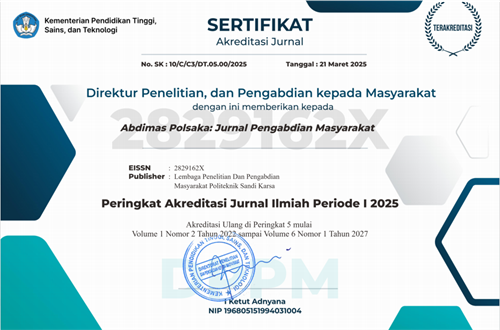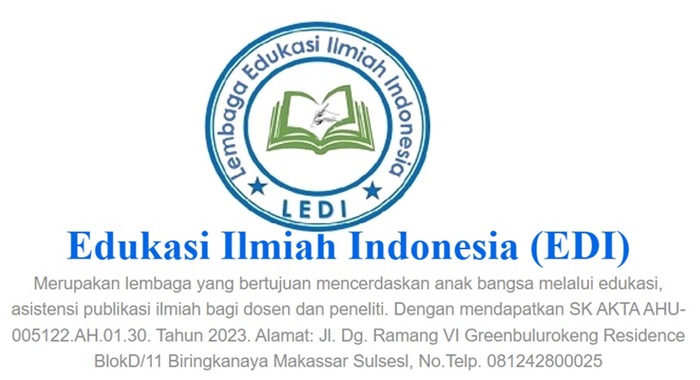Blood donation activities as a form of social concern for students and lecturers of polytechnic sandi karsa
DOI:
https://doi.org/10.35816/abdimaspolsaka.v4i1.92Keywords:
Blood donation, Community service, Humanitarian social work, Keen social responsibilityAbstract
Blood donation activities held by students and lecturers of Sandi Karsa Polytechnic are a form of community service that aims to increase social awareness and strengthen the relationship between the academic community and the surrounding community. This activity is carried out in collaboration with related institutions in the medical and humanitarian world, to ensure the sustainability of the blood supply that is urgently needed by hospitals and other health institutions. In this event, participants were invited to donate blood that is not only beneficial to the recipient, but also has a positive impact on the donor in terms of health. Through this activity, it is hoped that students and lecturers of the Sandi Karsa Polytechnic can apply the knowledge they have in the real world, as well as make a contribution that is directly felt by the community. This activity also aims to foster the spirit of mutual cooperation and concern for others, especially in facing health challenges that often require an adequate blood supply. With the theme "Sharing Together, a Drop of Blood for a Million Happiness", this blood donation activity is not only a place for the academic community to contribute to saving lives, but also as a means to strengthen social ties between universities and the wider community. This activity is expected to be a real example of the social responsibility that an educational institution can provide to the community, as well as be part of a sustainable community service culture
Downloads
References
Afshar Jahanshahi, A. (2025). Hope is not the last thing that dies: In hard economic situations, self-preservation becomes a priority over social responsibility. Journal of Environmental Psychology, 104, 102614. https://doi.org/https://doi.org/10.1016/j.jenvp.2025.102614 DOI: https://doi.org/10.1016/j.jenvp.2025.102614
Amul, G. G. H. (2025). Corporate social responsibility as a commercial determinant of health: A case study of the alcohol industry in the Philippines. Social Science & Medicine, 380, 118169. https://doi.org/https://doi.org/10.1016/j.socscimed.2025.118169 DOI: https://doi.org/10.1016/j.socscimed.2025.118169
Ariani, R. T., & Raldow, A. C. (2025). Impact of Social Media on Oncology Care. Hematology/Oncology Clinics of North America, 39(2), 413–429. https://doi.org/https://doi.org/10.1016/j.hoc.2024.12.001 DOI: https://doi.org/10.1016/j.hoc.2024.12.001
Asulin, Y., Heller, Y., Munichor, N., & Zultan, R. (2025). Social image, observer identity, and crowding up. Games and Economic Behavior, 152, 37–54. https://doi.org/https://doi.org/10.1016/j.geb.2025.04.003 DOI: https://doi.org/10.1016/j.geb.2025.04.003
Bescoby, C., Wiltshire, G., Gillison, F., & Arnold, R. (2025). Beyond the games: How sport-based social networks support illness self-management for organ transplant recipients. Psychology of Sport and Exercise, 76, 102772. https://doi.org/https://doi.org/10.1016/j.psychsport.2024.102772 DOI: https://doi.org/10.1016/j.psychsport.2024.102772
Bou Assi, T., Haddad, A., Ghanem, N., Chahine, R., Fazaa, E., Karaki, R., Feghali, R., Ghorra, P., Jisr, T., Hachem, B., Tarhini, M., Rohban, R., Hammoud, H., Jamal, M., El Amin, H., Nabulsi, M., & Garraud, O. (2024). Paths to improve voluntary blood donation in mixed public/private blood donation systems such as in Lebanon? Transfusion Clinique et Biologique, 31(3), 149–156. https://doi.org/https://doi.org/10.1016/j.tracli.2024.05.003 DOI: https://doi.org/10.1016/j.tracli.2024.05.003
Ciausescu, A., Merz, E.-M., Bekkers, R., & Wit, A. de. (2025). Increasing knowledge about plasma and plasma donation through a serious game: Evidence from a mixed-method study. Computers & Education, 233, 105325. https://doi.org/https://doi.org/10.1016/j.compedu.2025.105325 DOI: https://doi.org/10.1016/j.compedu.2025.105325
Dei, E. N., & Leitch, S. (2025). eHealth technologies for enhancing blood donor knowledge and behaviour: A PRISMA scoping review. Transfusion and Apheresis Science, 64(3), 104112. https://doi.org/https://doi.org/10.1016/j.transci.2025.104112 DOI: https://doi.org/10.1016/j.transci.2025.104112
Ding, C., & Ma, Q. (2024). Does social trust promote the size of enterprises? Evidence from China. Journal of Asian Economics, 91, 101705. https://doi.org/https://doi.org/10.1016/j.asieco.2023.101705 DOI: https://doi.org/10.1016/j.asieco.2023.101705
Easterbrook, A., Berger, M., Holloway, K., & Bansback, N. (2025). Developing a social model for blood and plasma donation. Social Science & Medicine, 379, 118189. https://doi.org/https://doi.org/10.1016/j.socscimed.2025.118189 DOI: https://doi.org/10.1016/j.socscimed.2025.118189
Espinoza Chamorro, R., Santos, L. H. O., Mori, Y., Liu, C., Yamamoto, G., & Kuroda, T. (2024). Gamification Approach to Provide Support About the Deferral Experience in Blood Donation: Design and Feasibility Study. JMIR Human Factors, 11. https://doi.org/https://doi.org/10.2196/50086 DOI: https://doi.org/10.2196/50086
Goette, L., & Tripodi, E. (2024). The limits of social recognition: Experimental evidence from blood donors. Journal of Public Economics, 231, 105069. https://doi.org/https://doi.org/10.1016/j.jpubeco.2024.105069 DOI: https://doi.org/10.1016/j.jpubeco.2024.105069
Gunn, J. L., Li, C., Liao, L., Yang, J., & Zhou, S. (2024). Audit firms’ corporate social responsibility activities and auditor reputation. Accounting, Organizations and Society, 113, 101569. https://doi.org/10.1016/j.aos.2024.101569 DOI: https://doi.org/10.1016/j.aos.2024.101569
Hiadzi, R. A., & Akrong, G. B. (2024). ‘It’s like donating blood’: Ghanaian university students’ knowledge and attitudes towards egg and sperm donation. Heliyon, 10(9), e30637. https://doi.org/10.1016/j.heliyon.2024.e30637 DOI: https://doi.org/10.1016/j.heliyon.2024.e30637
Karataş, H., & Balas, Ş. (2024). The liminal experience of awaiting for a cadaveric kidney donation: “I would not wish it on even my enemy!” Social Science & Medicine, 363, 117466. https://doi.org/10.1016/j.socscimed.2024.117466 DOI: https://doi.org/10.1016/j.socscimed.2024.117466
Maple, H., Gogalniceanu, P., Zuchowski, M., Draper, H., Burnapp, L., McCrone, P., Chilcot, J., Norton, S., & Mamode, N. (2025). Outcomes and motivations in unspecified (nondirected altruistic) kidney donation: Results from a United Kingdom prospective cohort study. American Journal of Transplantation. https://doi.org/10.1016/j.ajt.2025.03.021 DOI: https://doi.org/10.1016/j.ajt.2025.03.021
Overbey, D. M., Stephens, E. H., Parent, B., Ameduri, R. K., Catarino, P. A., Needle, J., Kucera, J. A., Kaldas, F. M., Biniwale, R., & Turek, J. W. (2024). Review of Current Normothermic Regional Perfusion Practice in Pediatric Cardiac Donation. The Annals of Thoracic Surgery. https://doi.org/10.1016/j.athoracsur.2024.11.026 DOI: https://doi.org/10.1016/j.athoracsur.2024.11.026
Scheffey, K., Aronson, J., Goncalves, Y., Greysen, S. R., Iwu, A., Kwong, P. L., Nezir, F., Small, D., & Glanz, K. (2025). Design and baseline characteristics of an implementation study to increase activity with social incentives: The STEP together trial. Contemporary Clinical Trials, 153, 107909. https://doi.org/10.1016/j.cct.2025.107909 DOI: https://doi.org/10.1016/j.cct.2025.107909
Suprapto, S., Arda, D., Kurni Menga, M., Hartaty, H., Halis, A., & Adji, B. (2024). Increasing public awareness through education and the implementation of routine blood donations. Jurnal Pengabdian Masyarakat Edukasi Indonesia, 1(3), 93–99. https://doi.org/10.61099/jpmei.v1i3.55 DOI: https://doi.org/10.61099/jpmei.v1i3.55
Vargas Meza, X., & Oikawa, M. (2024). Japanese Perception of Organ Donation and Implications for New Medical Technologies: Quantitative and Qualitative Social Media Analyses. JMIR Formative Research, 8. https://doi.org/10.2196/55797 DOI: https://doi.org/10.2196/55797
Xu, L., Qian, X., & Ling, M. (2025). Moderating the influence of social norms on climate change mitigation behavior: The roles of environmental beliefs, government quality, and policy incentives. Environmental Impact Assessment Review, 114, 107901. https://doi.org/10.1016/j.eiar.2025.107901 DOI: https://doi.org/10.1016/j.eiar.2025.107901
Zhang, X., Wang, X., Wang, D., Xiao, Q., & Deng, Z. (2024). How the linguistic style of medical crowdfunding charitable appeal influences individuals’ donations. Technological Forecasting and Social Change, 203, 123394. https://doi.org/10.1016/j.techfore.2024.123394 DOI: https://doi.org/10.1016/j.techfore.2024.123394

Additional Files
Published
How to Cite
Issue
Section
License
Copyright (c) 2025 Abdimas Polsaka: Jurnal Pengabdian Kepada Masyarakat

This work is licensed under a Creative Commons Attribution 4.0 International License.
Most read articles by the same author(s)
- Riska Sabriana, Rika Riyandani, Rosmiaty Rosmiaty, Pemberdayaan Pada Ibu Hamil Terhadap Pengetahuan dan Sikap Ibu Mengenai Pemberian ASI Eksklusif , Abdimas Polsaka: Vol. 2 No. 1 (2023): Abdimas Polsaka: Jurnal Pengabdian Masyarakat




















